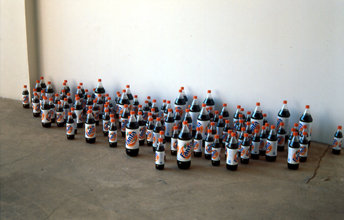Hlynur Hallsson
dal 5/11/2008 al 10/1/2009
Segnalato da
5/11/2008
Hlynur Hallsson
Reykjavik Art Museum, Reykjavik
Out / In. Twenty shops and companies in the centre of the city participate in a project by the artist. The exhibition aim is to bring works from the Museum's collection out to the public and at the same time spread a new light on common objects in our surroundings and put them in new context within the museum's wall. Hallson challenges neutrality and invites the viewer to experience and evaluate the works in a context far removed from the environment of the museum.

OUT to the city IN to the museum
OUT of the frame IN to art
In the context of art and cultural history, the word “safn” in Icelandic, has a twofold meaning. “Safn” is, on the one hand, a museum, a building open to the public, in which works of art or objects are displayed and preserved. On the other hand, “safn” refers to a collection – the works of art or objects accumulated and preserved in the institution. Whether “safn” is seen as a building or a collection, it has symbolic meaning and embodies cultural power. This power has inspired many artists to consider both, the value of art and the viewer as a part of a social entity.
Hlynur Hallsson’s work, OUT/IN, is an investigation of the museum as a semantically loaded site. The artist seeks to highlight the conventions and the experiences of viewers in the traditional space of the museum. This Hallsson does by taking works of art out of their “natural habitat” of the exhibition space and bringing in to the museums objects that are not defined as works of individual artists. For this purpose, Hallsson borrows works from the collection of the Reykjavik Art Museum to exhibit them at stores and other establishments of service and goods in the city center. He then takes exchange objects, from these same places and exhibits them in the museum as works of art. The objects, in both cases, are then put into new contexts, thus challenging received ideas about what kind of sites are suitable for works of art, worthy of being collected and preserved for “all eternity“. The viewer’s experience of the works is, then, partly destabilized as he hasn’t the social references and codes of conduct shaped by the museum for centuries.
Since before the middle of the 20th century the concept of the white cube has been dominant in the representation of art in museums and other exhibition spaces – unique works in a neutral space. The idea of neutrality has developed in the last decades and contemporary museums are often the spatial and/or conceptual premises of the works exhibited there. Hallson’s work is of this kind; he challenges neutrality and invites the viewer to experience and evaluate the works in a context far removed from the environment of the museum. This approach not only asks questions that relate to the semantically loaded site of the museum, but also broaches questions that have to do with the viewer’s experience of art. Under what circumstances do people allow themselves to look for the inner context or the true value of objects?
The objects Hallsson has selected to exhibit in the museum are either ordinary commodities, sold in stores, or objects related to the service sector, and therefore have a strong reference to the consumer society, a phenomenon that the museum tends to distance itself from. When the objects have entered the museum they are treated as art and presented in line with the protocols and rules of the museum. The users of services and consumers in down-town stores usually look at these mundane objects as commonplace, quite empty of meaning. The site, however, unavoidably affects this attitude. The atmosphere of the museum in an exhibition like the present one, in which practical objects are brought into the museum, are not necessarily different from many contemporary exhibitions in which readymades are seen as art, or used to form a part of a work of art – albeit under different banners.
Hlynur Hallsson turns the museum upside-down and disseminates works of art throughout the city center. He goes on to import ordinary objects into the museum where they are then put on a pedestal, so to speak, as art. Hallsson challenges the received system of values and the principles that govern art exhibited in the museum’s exhibition spaces, art collections, the exhibition spaces and the context of the same. The present exhibition is a journey that explores inner values as well as a journey through the center of Reykjavik. Bon voyage!
Ólöf K. Sigurðardóttir, curator
HAFNARHÚS / OUT / IN
sunday 30 November 3 p.m.
Artist’s Talk Hlynur Hallsson.
Reykjavík Art Museum
Hafnarhús
Tryggvagata 17 Reykjavik
The museums are open every day from 10:00am - 5:00pm - Thursday 10:00am - 10:00pm



